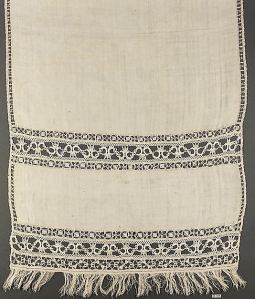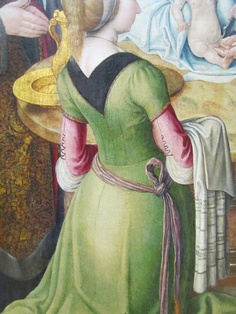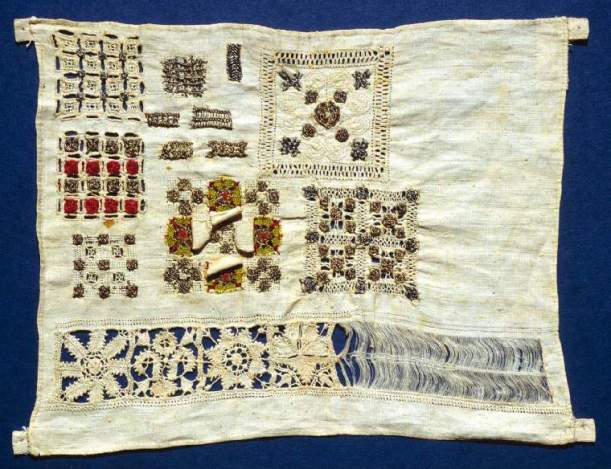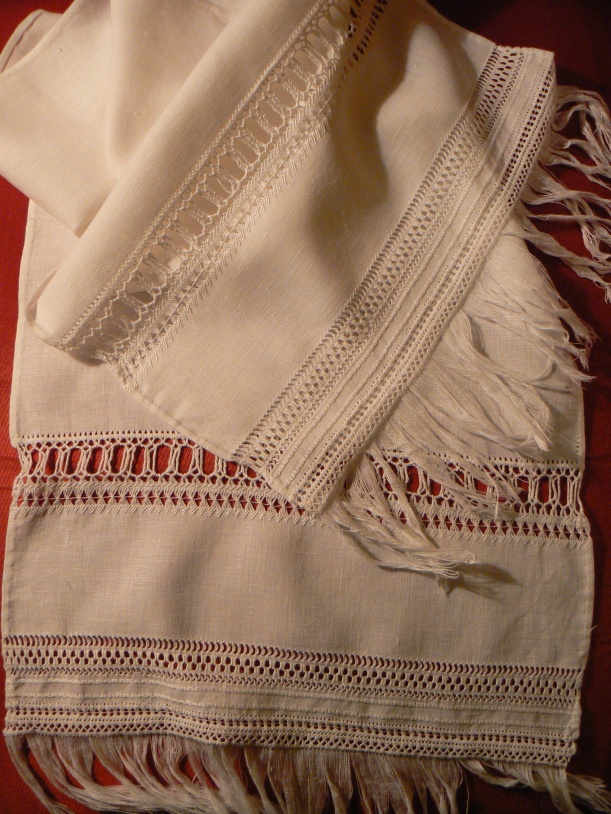Here is a little project I just completed, 12 small embroidered pouches to be donated to the crown of Atlantia for largess. The Spike is my own design. The pouches are linen with cotton embroidery. I used stem stitch and little bit of satin stitch on them. I included a beginning embroidery kit with each one: A piece of blue fabric with the same Spike drawn onto it, white embroidery floss, a small embroidery hoop, a needle, and instructions on how to make a mug cover with their finished piece.

Monthly Archives: April 2014
Drawing some conclusions about drawn-thread work
Someone, on Pinterest or Facebook posted a a detail view of the painting “The Circumcision” by The Master of Saint Severn ca 1490. I’m sure that they did so because, they were pointing out the construction details of the green dress. I however became fascinated by the towel the lady in green was holding.
Clearly the painting was depicting a drawn thread work towel. I had been thinking about expanding my embroidery comfort zone, and this seemed like an interesting project. I knew that towels would be fairly easy to research. The real question was, could I find enough evidence of this style of drawn-thread embroidery to justify a SCA A&S entry? I combed though books about embroidery, and lace making, searched web sites, looked at hundreds of paintings and what I found was…there is very little written about this type of work being done in the middle ages.
Single drawn-thread work or Punto Tirato is mentioned briefly by several authors as a precursor to later more ornate work such as Reticello. To be fair there is a lot of “How to” type of information from the mid 1800’s through the early 1900’s and most of these authors are not writing for an academic audience. They are writing for housewives looking for a ladylike hobby to fill their free time. Emily Jackson in her book A History of Handmade Lace: Dealing with the Origin of Lace. The Growth of the Great Lace Centres, The Mode of Manufacture, The Methods of Distinguishing and the Care of Various Kinds of Lace. (yes, that whole thing is the title of the book) dedicates a chapter to the evolution of lace in the middle ages. However most of the examples she gives are of pulled thread work, where the warp and weft are gently tugged out of place by stitching in order to form a textural pattern on the cloth. She does show one photograph of a drawn linen work with Arabic inscription from a tomb in upper Egypt, but she gives no date or provenance for the piece.

there does seem to be a general consensus from people writing on the subject, that drawn-thread work was being done in the middle ages, they just don’t give me any information to prove it. So, on to museums to find an extant piece .

Late 16th century Culture: Italian Medium: Linen, bobbin lace Dimensions: L. 73 x W. 18 inches 185.4 x 45.7 cm

16th century Culture:Greek Islands Medium:Linen, needle lace Dimensions: L. 57 x W. 28 Metropolitan Museum of Art
First of all, I looked at a lot of searchable online museum catalogs but by no means all of them, and this is what I found. There are a substantial number of extant household linens with some sort of drawn work or cut and drawn work. Most of them fall into the Reticello end of the spectrum like these above examples. I also found a lot of promising descriptions with no photo on file. So no luck finding an extent example of the type of drawn-thread work I am looking for…so far, I’m still looking. The closest I’ve come is this sampler from between 1600 and 1650 at the Victoria and Albert Museum in London. And a sampler From the Fitzwilliam Museum in Cambridge. It’s very exciting because in addition to Reticello and Punto Tagliata, there is clearly a box of Punto Tirato around the gold work in the upper row right hand side. And even though its really hard to see at this size there are rows of double pea-hole stitch above and below the reticello row still in progress.

Sampler – England Date:1600-1650 (made) :Linen, embroidered with linen, with cut-work and drawn thread work
So, at this point I have to ask, why can’t I find any examples of this type of work on actual house hold linens?
1. There are none, because it wasn’t done in period. I don’t think this is the answer. I’ve got the picture of the towel in the the “Circumcision” painting that I’ve already shown you. I’ve found samplers that while at the very end of or just outside our SCA Period I feel are enough to justify the techniques being used in our period. Plus I have found several other paintings of linens that I will show you in a moment.
2. I haven’t looked in the right place, yet. I think this has something to do with it.
3. Time is hard on textiles, the farther back in time we go the fewer examples of any textiles remain and the ones that do are usually things that people value, either because of their intrinsic value, gold work for example or their ceremonial value. We have a lot more altar cloths than we have every day household linens. Why? You ask, Because Altar cloths are perceived as being special, special care is taken to save them. On the other hand, people don’t tend to hang on to their great, great, great Grandmother’s old natty dish cloth.
4. Paper making, with the advent of the printing press in 1450 a new job was invented, the Rag Man. Linen rags where collected and recycled into paper.
5. Fire, mildew, dry-rot, etc.
So I haven’t found any extant evidence (yet) but I still think that drawn-thread work done in rows, on household linen was being done in the high middle ages. I haven’t found any extant examples. or academic citations proving this was a thing. What makes me think it was?
I found pictures. That’s right dear reader pictorial evidence. I looked at hundreds of paintings and illustrations. Paintings of dinners. Paintings of presentations at the temples. Paintings of births of the virgin. Illustrations of brothels, hospitals. Saints on their death beds. If it had a towel, a sheet, or a table cloth, I looked at it, and this is some of what I found.
In the picture below, we see an altar cloth that has a eight rows of drawn-thread designs, due to the size of the image it’s difficult to determine exactly what type of groupings are used to form the negative space patterns. But I believe that there are 3 rows of some kind of pea-hole or 4-sided stitch, and that the widest row, (the second from the top) is depicting a lattice work bundling of the warp threads. The main body of the cloth looks to be a lozenge weave of some kind, but it is possible that the white on white diamonds are embroidered. The worked rows are space randomly over what I estimate to be somewhere between the first 12 to 18 inches of the textiles length.
I think the above example is particularly magnificent. Here we have a cloth resting on a table that holds a pitcher and a shallow dish for hand washing. The towel is woven with stripes of yellow and black at regular intervals and at either end has a large band of geometric weaving. Below that are two rows of drawn-thread work the narrower one looks to me to be basic grouped bars. The wider of the two worked rows is more ornate. Groups of threads are bundled together then wrapped together to form a lattice style design, then the larger bundles are split again and knotted together to form the longer portion of the design.
In this detail we are looking at a bed sheet. There are two rows of drawn thread work, separated by a strip of cloth. The weft has been pulled out and the warp thread bundled into groups and then wrapped to form a pattern of alternating V’s. Also notice the end of the embroidered row has been worked with a bar probably wrapped or overcast with a button hole stitch to finish the end.

The Dream of St. Martin (detail) 1312-17 Fresco, Cappella di San Martino, Lower Church, San Francesco, Assisi
This table cloth depicts several rows of design in pale blue. They could be woven into the body of the cloth but I believe that they are rows of drawn-thread work. On either end of the table there is a wider row of design that looks a bit like a checkerboard pattern, when you look closely at them the squares are skewed slightly and there are connecting lines of white at an angle in the corners. This looks exactly like needle weaving to fill in withdrawn weft threads.

Haggadah, liturgical poems and biblical readings for Passover (The ‘Barcelona Haggadah’), Sephardic rite ., Catalonia (Barcelona) c. 1340 (detail)
Back to the image that started all this. This first 12 inches or so of this towel are worked with rows of drawn-thread spaced at random intervals ( the opposite end of the towel is not visible in the painting) and a 2-3 inch fringe. I can see several rows of pea-hole stitch, four rows of some kind of zig-zag work, and two rows of alternating blocks of needle weaving. It is impossible to say for sure but given the length of a woman’s forearm and the way the fabric is gathered in a loose S curve, I would guess the width of this piece is between 15 and 21 inches. I would estimate the total length to be between 5 and 6 feet.
So that is five good solid depictions of drawn-thread work in period, from between 1320 to 1520. Two Netherlandish one Italian, one German and one Spanish. Plus two samplers from England that are dated at the end or slightly past our SCA time period. I have a lot of other paintings and drawings that have Linens that could be drawn-thread work, but I felt that these are some of the strongest ones.
I would like to briefly touch upon what I found out about towels in the middle ages before I move on to my entry. All the evidence that I found points to towels being longer and narrower than what we would expect in a modern towel. Judging by the extant pieces that I found and many many images of towels in art work, the average house hold towel what somewhere between 12-24 inches wide and 4-8 feet long. They where used as a general textile. By that I mean the same cloth could be used as a towel, a table cloth, or perhaps to wrap around a hot item to protect the skin from burns. Individual napkins don’t appear until late in our period, so towels were used communally at table. A servant would present the guest with a clean spot, and then the next user would simply use the next available spot. Towels were most often linen ( there is a reason we still call household textiles Linens, even though we all use cotton now). The fancier the towel the wealthier the household. Also simple unadorned towels seem to be used in public spaces such as bath houses where items would be getting a higher level of use, and be more likely to wander off.
What I did
I decided that I wanted to make a towel more along the lines of the one in the Saint-Severen painting. I started with a piece of Linen Fabric not quite 5 feet long and about 15 inches wide. I cut a width from a larger piece of fabric I already had at hand. I think that they would have probably used cloth woven to width. But I am not a weaver, and 15x 60 linen is not a size available at most fabric stores. I left room at both ends for a 3 inch fringe (in the picture below the fringing has not been done yet).
In Period the embroidery would have been worked in linen thread. I worked small samples with several readily available linen threads and wasn’t happy with the way they worked up. I ended up using #12 mercerized cotton crochet thread. And’ while not ideal I think it is close to what they would have used in period . Also it was relatively easy to purchase , and I didn’t have to deal with the Italian postal service. I have located 2 online sources for linen lace making supplies, what I ordered should be arriving soon. The fact of the matter is that no one is producing the wide range of linen threads that would have been made in the middle ages. So for reasons of availability and frugality I chose to work with cotton thread over linen.
I worked both ends to match each other. My research leads me to believe that this was done more often than not. I have seen images of textiles where only one end was worked, and textiles where the rows of decorations are placed randomly along the body of the piece. Any of these would be appropriate, I like both ends to match, so that is what I did.

Starting at the Left and working Right
Rows 1 and 2 – I worked a double pea-hole stitch also sometimes called four sided stitch, grouping my weft thread in bundles of 4. In the wider negative space, between the first and second row of 4-sided stitch I bunched threads into bundles of 4 each, at the opposite side of that space I split the bundle taking 2 threads from group one and 2 from group two, then half of 2 and half of 3 and so on giving the row a lattice work appearance. Row 2, I worked by intertwining bundle 1 and bundle 2 making serpentine S curves. I found no evidence of this being done in period, but given the limited number of examples and the fact that this type of stitch is such an important part in the modern vocabulary of drawn-thread work I felt it was justified.
Row 3 – I pulled 2 rows of 2 weft thread and worked 4 rows of darning stitch back into them, giving them a nice raised texture.
Row 4 – again I bundled my weft in groups of 4, but this time I alternated where I started on the top and bottom of the space to create zig-zag triangles in the negative space.
Row 5 – I used needle weaving to group bundle 1 and 2 then at the half way point switched to weaving bundle 2 and 3 together, then back up to 3 and 4. this is what gives this row a checkerboard look. ( it took foooorrrrevvver)
Row 6 – bundled the weft together in groups of 4 and left the bars un-worked.
Big open space
Row 7 – bundled my weft into groups of 3, then used a coral stitch to collect 4 groups of weft bundles into sheaves
Row 8 – bundled my weft into groups of 6, then wrapped half of 1 to half of 2, half of 2 to half of 3, then split half of new bundle 1 to half of bundle 2 and so on. This recreates the pattern seen on the yellow and white towel in de Beers “Birth of the Virgin”. The center-most side of this row is worked in 4 sided stitch to bundle the weft.
- Bibliography
Bage, Patricia. Beginner’s Guide to Drawn Thread Embroidery. Tunbridge Wells: Search, 2007. Print.
Balant, Tina. Zlate-Ost. Rep. N.p., n.d. Web. 12 Apr. 2013. <http://www.zlate-ostroge.org/clanki%20arhiv/otirace.htm>.
Celestina Ekaterina Gradianska Aka Tina Balant. “Otirace.” Otirace. N.p., n.d. Web. 20 Sept. 2013. <http://www.zlate-ostroge.org/clanki arhiv/otirace.htm>.
Dillmont, Thérèse De. The Complete Encyclopedia of Needlework: Anniversary. Philadelphia: Running, 2002. Print.
Endrei, Walter. “Les Étoffes dites de Pérouse, leurs antécédents et leur descendance.” Bulletin du CIETA, no 65 (1987), pp. 61-68.
Esther, Fangel. Danish Pulled Thread Embroidery. New York: Dover, 1977. Print.Furnivall, Frederick James, Edith Rickert, and Frederick James Furnivall, eds. The Babees’ Book: Medieval Manners for the Young,. London: Chatto & Windus, 1923. Print.
Jackson, Emily. A History of Hand-made Lace: Dealing with the Origin of Lace, the Growth of the Great Lace Centres, the Mode of Manufacture, the Methods of Distinguishing and the Care of Various Kinds of Lace. London: L.U. Gill, 1900. Print.
Leach, Agnes M. Drawn Fabric Embroidery. Mineola, NY: Dover Publications, 2001. Print.
Lefébure, Ernest. Embroidery and Lace; Their Manufacture and History from the Remotest Antiquity to the Present Day. A Handbook for Amateurs, Collectors, and General Readers. London: H. Grevel, 1888. Print.
Manetti, Maria M. Il Punto Antico. Firenze: Libreria Editrice Fiorentia, 1999. Print.
McNeill, Moyra. Drawn Thread Embroidery. London: Batsford, 2005. Print.
McNeill, Moyra. Pulled Thread Embroidery. New York: Dover Publications, 1993. Print.
Powys, Marian. Lace and Lace-making. Mineola, NY: Dover Publications, 2002. Print.
Preston, Doris Campbell. Needle-made Laces and Net Embroideries: Reticella Work, Carrickmacross Lace, Princess Lace, and Other Traditional Techniques. New York: Dover Publications, 1984. Print.
Ricci, Elisa. Old Italian Lace: By Elisa Ricci. London, Philadelphia: William Heinemann, J.B. Lippincott, 1913. Print.
Slocumb Di Brazza, Cora. A Guide to Old and New Lace in Italy Exhibited at Chicago in 1893. Chicago: W.B Conkey, 1893. Print.
Thomas, Mary. Mary Thomas’s Embroidery Book: Including Appliqué, Patchwork, Quilting, Initials, and Monograms, Fringes, and Tassels, Smocking, Seams, and Hems. New York: Dover Publications, 1983. Print.
Variety. Italian Drawn Work and Antique Filet Lace: Book No. 3. Boston, MA: Carmela Testa, 1922. Print.








